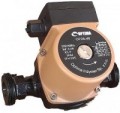Max. flow
The maximum flow of a pump is the amount of liquid it can pump in a certain amount of time.
Features of choosing the optimal performance option depend primarily on the purpose of the pump (see above). For example, for DHW recirculation models, the pump performance should not exceed the performance of the water heater. If the water heater is capable of delivering 10 litres per minute to the DHW circuit, then the maximum pump performance will be 10*60=600 L/h. The basic formula for calculating the performance of a heating system takes into account the power of the heater and the temperature difference at the inlet and outlet, and for the cold water system — the number of points of water intake. More detailed information about the calculations for each application can be found in special sources, and it is better to entrust the calculations themselves to professionals.
Max. operating pressure
The highest pressure in the circuit at which the pump will be able to work normally.
Of course, this parameter cannot be exceeded — the unit may fail due to a breakdown caused by too high pressure (and even if this did not happen right away, it can happen at any time). However, it is worth choosing a model with some margin — so that the pump can normally withstand pressure surges, which are almost inevitable in any pipe.
Minimum fluid temperature
The lowest fluid temperature at which the pump is capable of operating normally.
Almost all pumps can normally transfer cool water, regardless of the purpose (see above); therefore, for normal household use, this parameter is not critical and for some models, it may not be indicated at all. But if you need the ability to work with liquids with temperatures below 15 °C, you should pay close attention to the minimum temperature. Some models that can be used with antifreeze normally tolerate even temperatures below zero.
Max. power consumption
The electrical power consumed by the pump during normal operation and maximum performance.
This indicator directly depends on performance — after all, for pumping large volumes of water, an appropriate amount of energy is needed. And the power depends on two main parameters — electricity consumption and the load on the power grid, which determines the connection rules. For example, pumps with a power of more than 5 kW cannot be connected to ordinary household sockets; more detailed rules can be found in special sources.
Motor type
The type of electric motor provided in the design of the pump.
— Asynchronous. Engines of this type have the simplicity of design and low price, combined with reliability. Their main disadvantage is the dependence of the rotational speed on the load, which leads to the fact that it is difficult to adjust this frequency accurately for such an engine. At the same time, for domestic use, it is not critical and in the professional sphere, it rarely creates difficulties. Therefore, induction motors are very popular in modern pumps.
— Synchronous. Synchronous motors are distinguished by high accuracy in speed control — it practically does not depend on the load on the rotor; this is their main advantage over asynchronous ones. On the other hand, this type is more complex and expensive, and the need for fine adjustment is quite rare. Therefore, synchronous electric motors are mainly installed in high-end pumps designed for use in specific conditions.
Country of brand origin
In this case, the country of origin refers to the country from which the product brand originates. A brand, in turn, is a general designation by which the products of a particular company are known in the market. The country of its origin does not always coincide with the actual place of production of the product: to reduce the cost of production, many modern companies transfer it to other countries. It is quite normal for products, for example, of an American or German brand, to be made in Taiwan or Turkey. Contrary to popular belief, this in itself does not lead to a decrease in the quality of the goods — it all depends on how carefully the brand owner controls the production. And many companies, especially large and famous ones, monitor the quality very zealously — after all, their reputation depends on it.

